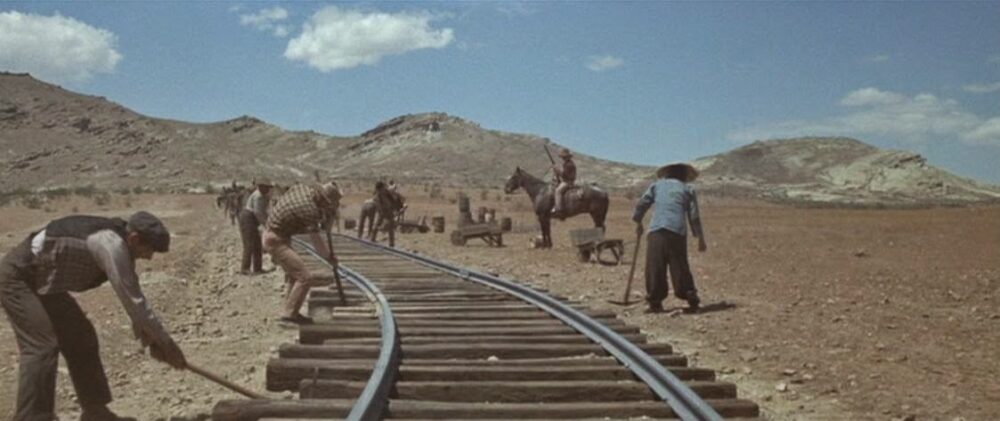The opening shot of the 1974 film Mel Brooks’ “Blazing Saddles” features a diverse group of railroad workers; many of whom hail from minority communities mistreated and verbally abused by a bunch of rowdy white hypermasculine cowboys. Just as when the leader of the hypermasculine cowboys attempts to bully a group of Black workers into singing a ‘slave song’; the movie introduces us to Bart (Cleavon Little). Our protagonist outsmarts the leader and gives him a taste of his own medicine; making him sing and dance to ‘De Camptown Races’ himself, leading to a berating from his superior.
This scene, which Brooks co-wrote with comedian Richard Pryor, basically lays down the track for the rest of the movie. “Blazing Saddles” manages to touch upon critical themes and sociopolitical issues throughout its running time.
A Black Comedy One Can Expect from Mel Brooks
Like most Mel Brooks-helmed comedies, “Blazing Saddles” contains its share of iconic one-liners that are still quoted by fans of the movie today; a personal favorite being “Where the white women at?” The film also features running gags such as the residents of the predominantly white town of Rock Ridge who all share the same last name (Johnson) comically responding in chorus to anything that Sheriff Bart says. There is also the ‘Hedy Lamarr‘ gag that is not only a pun on an influential celeb’s name, but one that also ties in quite well with the climax.
“Blazing Saddles” also treats the viewers to visual gags galore and double entendre that’ll leave them chortling. Brooks’ signature gag of randomly incorporating ‘schnitzengruben’ (a large German sausage) into a conversation between two romantically involved characters also brought back fond memories of watching “Young Frankenstein” all over again. And I must admit that until “Fleabag” came along, this movie probably held the record for most amount of fourth wall breaks (a lot of them quite literal ones).

‘Blazing Saddles’ and a Closer Look on the Power of Satire
But what I found most striking about “Blazing Saddles” is that it’s not just meant to be an ordinary run-of-the-mill bawdy parody. Instead, it also works brilliantly as a clever satire on certain bigotry-laced practices prevailing in the United States.
An example that firmly establishes this is the scene involving an indigenous American chief speaking Yiddish. Yes, this scene might seem like a throwaway gag at first. In fact, it did leave me scratching my head initially, too. Nonetheless, after learning about the historical implications behind it (apparently it could very well be based on the theory that indigenous American tribes were once considered as descendants of a lost Israeli tribe); it does open up doors to various other interpretations.
Case in point: the indigenous chief is played in red face by Mel Brooks himself, a person of non-indigenous descent. Taking into consideration Hollywood’s notorious history of whitewashing and indigenous culture erasure, I wouldn’t put it past Brooks to satirize this very aspect through this scene.
Of Mocking the Tired Clichés and Tropes
Moreover, the entirety of this movie dedicates itself to ridiculing a lot of outlandish and outdated tropes in the film industry and movies; which, in turn, constantly force viewers to suspend their disbelief in favor of brainless stunts and little to no storylines.
There is a clever subversion of many clichés and persisting tropes in the film. These include the trope of the vaguely European femme fatale via Madeline Kahn’s character Lili Von Schtupp; the trope of the soft-spoken elderly woman via the character of the schoolmarm; and even the illogical gunslinger stunts that were Clint Eastwood’s bread and butter back in the day. And with the comical Waco Kid sequences satirizing tropes that even Salman Khan in Bollywood still use to this day; it gave me great pleasure watching such brainless and nonsensical stunts utilized as the comedic gags that they rightfully are.
On the Merits of the Cast
“Blazing Saddles” allowed for everybody in the cast to hold their own in their respective roles. Even so, I couldn’t help but think that the lead pair of Gene Wilder and Cleavon Little (Jim the Waco Kid and Sheriff Bart, respectively) would have certainly benefited from a spin-off film. It’s something that could have further highlighted the electrifying camaraderie they shared and their ability play off each other. Madeline Kahn too managed to hold my attention with her showmanship; and despite the character’s initial malicious intent, I did feel sorry for Lili Von Schtupp when Sheriff Bart put her in the friend zone. My only complaint was that some of the topical pop culture references didn’t quite land for me. Nevertheless, I will have to blame that mainly on me being born in the wrong era (I had to Google who Randolph Scott was, by the way).
Go in with an open mind. You may or may not understand some of the more topical pop culture references that are in keeping with the era; but you’ll definitely come out of “Blazing Saddles” feeling a little bit more enlightened and more accepting. And if you ask me, it’s just the kind of attitude we require more of in the modern day.